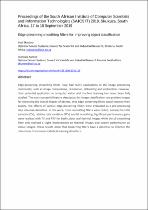JavaScript is disabled for your browser. Some features of this site may not work without it.
- ResearchSpace
- →
- Research Publications/Outputs
- →
- Conference Publications
- →
- View Item
| dc.contributor.author |
Skosana, Vusi J

|
|
| dc.contributor.author |
Kunene, Dumisani C

|
|
| dc.date.accessioned | 2019-10-17T08:39:49Z | |
| dc.date.available | 2019-10-17T08:39:49Z | |
| dc.date.issued | 2019-09 | |
| dc.identifier.citation | Skosana, V.J. & Kunene, D.C. 2019. Edge-preserving smoothing filters for improving object classification. In: Proceedings of the South African Institute of Computer Scientists and Information Technologists (SAICSIT) 2019, Skukuza, South Africa, 17 to 18 September 2019 | en_US |
| dc.identifier.isbn | 978-1-4503-7265-7 | |
| dc.identifier.uri | https://dl.acm.org/citation.cfm?id=3351125 | |
| dc.identifier.uri | https://doi.org/10.1145/3351108.3351125 | |
| dc.identifier.uri | http://hdl.handle.net/10204/11172 | |
| dc.description | Presented in: Proceedings of the South African Institute of Computer Scientists and Information Technologists (SAICSIT) 2019, Skukuza, South Africa, 17 to 18 September 2019. Due to copyright restrictions, the attached PDF file contains the abstract of the full-text item. For access to the full-text item, please consult the publisher's website. https://dl.acm.org/citation.cfm?doid=3351108.3351125 | en_US |
| dc.description.abstract | Edge-preserving smoothing filters have had many applications in the image processing community, such as image compression, restoration, deblurring and abstraction. However, their potential application in computer vision and machine learning has never been fully studied. The most successful feature descriptors for image classification use gradient images for extracting the overall shapes of objects, thus edge preserving filters could improve their quality. The effects of various edge-preserving filters were evaluated as a pre-processing step inhuman detection. In this work, three smoothing filters were tested, namely the total variation (TV), relative total variation (RTV) and L0 smoothing. Significant performance gains were realised with TV and RTV for both colour and thermal images while the L0 smoothing filter only realised a slight improvement on thermal images and poorer performance on colour images. These results show that smoothing filters have a potential to improve the robustness of common statistical learning classifiers. | en_US |
| dc.language.iso | en | en_US |
| dc.publisher | ACM | en_US |
| dc.relation.ispartofseries | Workflow;22677 | |
| dc.subject | Datasets | en_US |
| dc.subject | Edge-preserving smoothing filters | en_US |
| dc.subject | Human detection | en_US |
| dc.subject | Image processing | en_US |
| dc.subject | Image compression | en_US |
| dc.subject | Relative total variation | en_US |
| dc.subject | RTV | en_US |
| dc.subject | Total variation | en_US |
| dc.subject | TV | en_US |
| dc.subject | Support vector machines | en_US |
| dc.title | Edge-preserving smoothing filters for improving object classification | en_US |
| dc.type | Conference Presentation | en_US |
| dc.identifier.apacitation | Skosana, V. J., & Kunene, D. C. (2019). Edge-preserving smoothing filters for improving object classification. ACM. http://hdl.handle.net/10204/11172 | en_ZA |
| dc.identifier.chicagocitation | Skosana, Vusi J, and Dumisani C Kunene. "Edge-preserving smoothing filters for improving object classification." (2019): http://hdl.handle.net/10204/11172 | en_ZA |
| dc.identifier.vancouvercitation | Skosana VJ, Kunene DC, Edge-preserving smoothing filters for improving object classification; ACM; 2019. http://hdl.handle.net/10204/11172 . | en_ZA |
| dc.identifier.ris | TY - Conference Presentation AU - Skosana, Vusi J AU - Kunene, Dumisani C AB - Edge-preserving smoothing filters have had many applications in the image processing community, such as image compression, restoration, deblurring and abstraction. However, their potential application in computer vision and machine learning has never been fully studied. The most successful feature descriptors for image classification use gradient images for extracting the overall shapes of objects, thus edge preserving filters could improve their quality. The effects of various edge-preserving filters were evaluated as a pre-processing step inhuman detection. In this work, three smoothing filters were tested, namely the total variation (TV), relative total variation (RTV) and L0 smoothing. Significant performance gains were realised with TV and RTV for both colour and thermal images while the L0 smoothing filter only realised a slight improvement on thermal images and poorer performance on colour images. These results show that smoothing filters have a potential to improve the robustness of common statistical learning classifiers. DA - 2019-09 DB - ResearchSpace DP - CSIR KW - Datasets KW - Edge-preserving smoothing filters KW - Human detection KW - Image processing KW - Image compression KW - Relative total variation KW - RTV KW - Total variation KW - TV KW - Support vector machines LK - https://researchspace.csir.co.za PY - 2019 SM - 978-1-4503-7265-7 T1 - Edge-preserving smoothing filters for improving object classification TI - Edge-preserving smoothing filters for improving object classification UR - http://hdl.handle.net/10204/11172 ER - | en_ZA |






